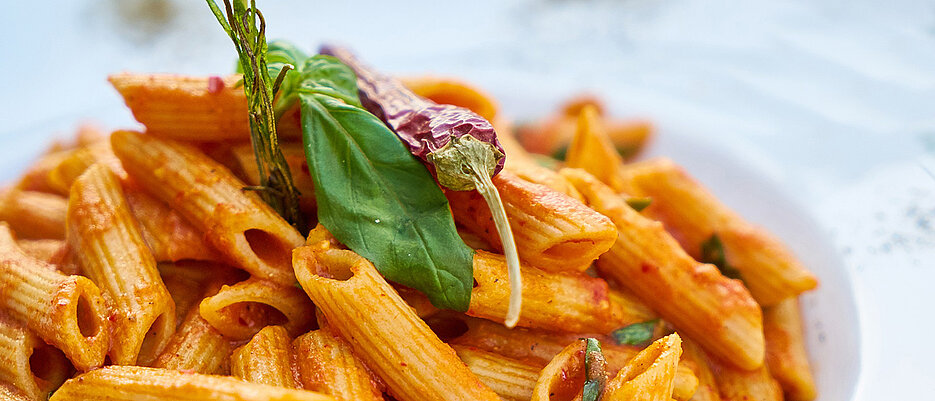Menus for climate-friendly food choices
05/11/2022If restaurants list the CO2 emissions for each dish on their menus or highlight low-emission options, diners are more likely to choose more climate-friendly options. This has been shown in a new study by the University of Würzburg.

The fact that a beef steak is significantly worse for the climate than a tofu schnitzel has probably become common knowledge by now. After all, cows are considered an enormous burden on the climate and a driving force for climate change, among other things because of their methane emissions. Nevertheless, Germans still consume an average of 55 kilograms of meat per year - according to the evaluation of the Federal Ministry of Food and Agriculture for the year 2021.
Scientists at the Julius-Maximilians-Universität of Würzburg (JMU) have now investigated the extent to which restaurants can contribute to curbing the climate crisis by redesigning their menus. Specifically, the question was whether colour-coded information about the greenhouse gas emissions of dishes - so-called CO2 labels - and a changed standard option for dishes with interchangeable side dishes nudge guests to more climate-friendly dish choices.
Burger without beef
The result: "The participants in our study chose the veggie burger more often when it was presented as the standard option on the menu - and not the beef burger, as is usually the case," explains Dr Benedikt Seger. Coloured CO2 labels had the effect that restaurant guests increasingly chose dishes with lower CO2 emissions.
Seger is a psychologist and research associate at the JMU Department of Developmental Psychology. Together with Master's student Ann-Katrin Betz, he led the study that has now been published in the scientific journal PLOS Climate.
Menus with variable dishes
As part of the study, 265 volunteers were presented with menus from different restaurants online - the menus included Italian, Indian and Mexican restaurants as well as a kebab restaurant. Seger and Betz had put together nine potential menus. These were either provided with information about the respective greenhouse gas emissions. Or they appeared sometimes with the low-emission standard component, and sometimes with the high-emission option. An example of such a dish was a couscous salad that could be ordered with beef (high emission), shawarma (poultry; medium emission) or falafel (low emission).
The analysis of the results showed that participants chose more climate-friendly dishes when CO2 labels were available and when the standard options consisted of low-emission rather than high-emission ingredients. In this context, changed default options - called “default shifts” in psychological language - led to an average of 300 grams less CO2 and coloured labels led to 200 grams less CO2 per ordered meal. "These are remarkable results when you consider that by no means all of the participants in the study gave up meat dishes and other CO2-intensive meals because of the defaults or labels," says Seger.
Not a matter of course
According to the psychologists, an important finding from this study is that people are obviously willing and able to consider the pressing problem of the climate crisis even in small everyday decisions such as ordering a meal. "This is by no means self-evident when we consider that in a restaurant we enjoy the food, the atmosphere and the get-together with others, so we do not want to think about existential threats like the climate crisis," says Seger.
From a psychological point of view, the decision for climate-friendly food is not unexpected: "We assume that CO2 labels and changed standards convey certain social norms. After all, the imperative to emit as little carbon dioxide as possible is now established in large parts of the population," explains Seger. Thus, when a restaurant discloses the CO2 emissions of the dishes it offers, guests realise that this standard also applies to food choices in restaurants. This is all the more true if these are additionally emphasised by corresponding colours: red for a lot of CO2, green for little greenhouse gas.
Social normas influence beaviour
"If a restaurant highlights the vegetable patty instead of the meat patty as a standard option in its burger menu, it communicates: 'Guests at this restaurant usually order the veggie burger.' In psychology, we call this a descriptive norm," says Seger. This presumed knowledge of what others do in a certain situation - regardless of whether it is desired or accepted - can have a significant influence on behaviour.
Accordingly, Seger's message to restaurant operators is: "Have the courage to include CO2 labels and different standard options in your menu. This way you can contribute to climate protection without having to change your offer fundamentally."
Original Paper
How can carbon labels and climate-friendly default options on restaurant menus contribute to the reduction of greenhouse gas emissions associated with dining? Betz A-K, Seger BT, Nieding G (2022), PLOS Clim 1(5): e0000028.
https://journals.plos.org/climate/article?id=10.1371/journal.pclm.0000028
Contact
Benedikt T. Seger, Institut für Psychologie, T: +49 163 207 0225, benedikt.seger@uni-wuerzburg.de






